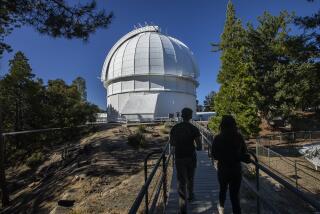Another Flaw in Hubble Telescope : Space: Oxide buildup on spectrograph’s mirror will hurt the device’s ability to analyze light. The setback is a further blow to NASA’s image.
- Share via
WASHINGTON — A new flaw has been discovered in a mirror aboard the problem-plagued Hubble Space Telescope, crimping a key instrument’s ability to analyze light from faint celestial objects, scientists and space agency officials said Wednesday.
While saying that the overall loss in scientific knowledge may prove negligible, observers said the development comes as another stunning blow to the National Aeronautics and Space Administration’s public image.
“This is certainly more bad news at a time when NASA doesn’t need any more,” said John Pike, associate director for space policy at the Federation of American Scientists.
“It cannot help but reinforce the growing concern over multibillion-dollar investments in single, large-science projects,” added John M. Logsdon, director of the Space Policy Institute at George Washington University.
The problem lies in the buildup of aluminum oxide in the mirror of the faint object spectrograph, an instrument designed to answer some fundamental questions about the universe through the study of light.
The buildup apparently occurred while the instrument sat in storage during much of the 1980s awaiting the telescope’s launching; it went undetected until recently, said George F. Hartig, the spectrograph’s chief scientist.
As a result of the excess aluminum oxide, the instrument’s ability to disperse faint light into its components is diminished, thus delaying the work of some astronomers while forcing others to vie for the precious remaining time on the $1.5-billion telescope’s other instruments. Those instruments already have been rendered less useful by an imperfection in the telescope’s 94.5-inch primary light-gathering mirror.
The problem with the faint object spectrograph comes amid speculation that NASA is considering an emergency repair mission to fix the telescope’s deteriorating gyroscopes, which are designed to keep the 12.5-ton telescope stable.
But even before two of the six gyroscopes failed, concern had developed over the orbiting telescope’s integrity because its massive solar panels become jittery whenever it passes from light to darkness. That led to fears that the metal support for the solar arrays could break, resulting in loss of the spacecraft’s power supply.
Last Friday, a third gyroscope “hiccuped,” said John Campbell, deputy associate director of flight projects for the Hubble Space Telescope.
Since its launching in April, 1990, the telescope has been using only four of the six gyroscopes because they were sufficient to control the instrument, Campbell said.
The problem with the gyroscopes has not interrupted any scientific experiments but it has prompted talk of a possible emergency space shuttle mission to repair the gyroscopes as well as the solar arrays, Campbell and other scientists said.
“If we don’t find a way of dealing with this, it could mean disastrous effects for science,” said John Bahcall, one of the Hubble’s leading researchers.
NASA said in a statement Wednesday that it is “not in the process of planning a mission” to the telescope before the already scheduled December, 1993, mission. At that time, astronauts will replace assorted instruments with new equipment designed to compensate for the telescope’s irreparably flawed primary mirror.
That flaw also went undetected until after the telescope reached orbit approximately 380 miles above Earth. After the defect was found, NASA scientists conceded that, until corrections can be made, the most important of the five instruments aboard would be virtually useless and three others would be useless half the time.
Despite NASA’s statement, Campbell said in an interview: “We have to consider the possibility that two more gyros might fail tomorrow. And if that happened, we would ask for an earlier servicing mission.”
The highly touted telescope, from its lofty position far above the Earth’s atmosphere, was supposed to revolutionize astronomy by bringing exquisite clarity to objects at the outer edges of the universe.
But, with each new problem, NASA engineers and the nation’s astronomers are coming under increasing pressure to make the repairs and get the scientific work done more quickly.
The faint object spectrograph is designed to allow scientists to analyze the entire spectrum of light and determine whether its source is hot or cold, along with its density, chemical composition and distance.
Some of the experiments no longer possible on the faint object spectrograph can be shifted to a similar instrument known as the Goddard High Resolution Spectrograph, Hartig said.
Trying Anew to Launch Atlantis
With the repair of a faulty engine computer complete and with a favorable weather forecast, the National Aeronautics and Space Administration has scheduled the launching of the space shuttle Atlantis for 8:01 (PDT) today. Mission facts:
Payload: A $120-million NASA communications satellite used to relay pictures and data from space shuttles, the Hubble Space Telescope and other spacecraft.
Duration: Nine days.
Experiments: Dozens of experiments are aimed at designing life support and computer systems for long-term manned flights aboard NASA’s planned space station Freedom. They include crew exercises, safety drills and germination of spinach seeds for a potential space station garden. One experiment will test whether 60 wasps devour wastes.
Crew: Four men and one woman.
Problems: The launching was first delayed a day to fix an electrical circuit controlling the shuttle fuel tank’s detachment from the orbiter after liftoff. NASA then halted the first countdown on July 24 because of a malfunctioning engine computer, which had to be replaced. Minor repairs were also made to a four-inch crack found on a floor beam of the orbiter.
Landing: Atlantis is scheduled to land at Kennedy Space Center, marking the start of a NASA plan to have most space shuttles land on a concrete strip a few miles from the seaside launching pads.






